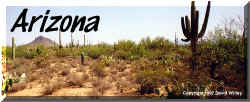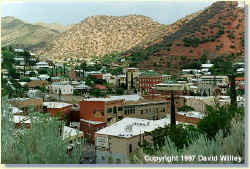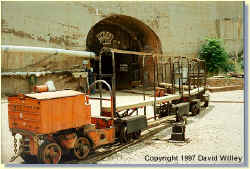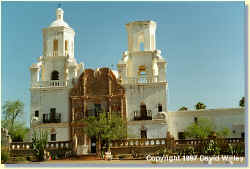 The Willey Travel Guide: Arizona (Part 2) - South to Tucson First stop was the Meteor Crater near Winslow (when I hear the Eagles song, Take it Easy, I can now say that I know where Winslow, Arizona is). The crater, which is over 4,000 feet in diameter, was formed by a 100' meteorite some 49,000 years ago. It is apparently one of the best preserved craters and was used by Apollo astronauts as a training ground. The visitor centre also has a nice display explaining meteorites. The Petrified Forest was next on the list. The park includes parts of the Painted Desert and the Chinde Point overlook was where we stopped for lunch. The view here was magnificent. You don't realize how isolated this is until you notice the absence of sound. There were two other people at the next table and we noted this "sound of silence" at the same time. It was a strange feeling, similar to when you enter a sound proofed room. In the Forest, we stopped at the various points of interest. The Agate Bridge loses some of its splendor due to the concrete which holds it up. The Newspaper Rock contains petroglyphs but they are in a ravine and must be seen from above. Bring binoculars if you want to see them. It is easier to see petroglyphs at the pueblo ruin. The Long Logs area included a large number of petrified logs in a small area. Taking of petrified wood is prohibited in the Park but there are two stores at the Southern entrance to the Park where petrified wood can be purchased. The unpolished wood pieces can be just as nice as the polished ones and are much cheaper. The drive south through the Apache nation was pleasant with nice mountain scenery. The best part of the drive was the fantastic views during the winding descent into the Salt River Canyon. As we approached Tucson the skies opened up once again with a late afternoon thundershower. Having left the dry weather in Ottawa, we were surprised by the amount of rain we saw during the week we were in Arizona...a supposedly drier place. We found out that there is a "rainy season" and that we were in the middle of it. This basically meant that it would be sunny and hot during the day with thunderstorms building up around 4 pm and lasting until about 7 pm. What we weren't prepared for were the flash floods that could quickly wash over low points in roads, like when we were approaching the B&B. It suddenly dawned on me that desert cities don't normally need storm sewers, so there was no place for the water to go but in the various "washes". In Tucson, we stayed at the Viewpoint B&B (520 297-9324) located in the northern foothills, just south of the Coronado National Forest. With giant saguarro cacti in front, the B&B offers great views of the mountains on one side and city lights on the other. Our host, Clara Vancurra, made us most welcome, including a breakfast of crepes topped with Lingonberries, a Swedish fruit. As the name implies, Saguarro National Park is home to the long armed cacti which grow only in the Sonoran Desert (see the picture at the top of the page). The saguarro are giants that can grow to 40 feet and live up to 200 years. However, they do not start to grow branches until they are about 50 to 75 years old. The natives harvest the fruit and make jellies. Located in the park is the Arizona-Sonora Desert Museum. This is a living museum that includes both flora and fauna of the desert, presented in a real desert setting! The museum volunteers are friendly and always available to provide explanations. People kept telling us that we should visit the museum early in the day. We found out why...it is hot in the desert around noon! Drink plenty of water and periodically seek the shelters located throughout the park. This is a must-see attraction. Christopher was really looking forward to visiting the Biosphere 2, which is located in Oracle, about 30 minutes north of Tucson. I was also interested in seeing the various ecosystems up close. However, the tour of the Biosphere facility itself only includes the habitat area. You are not permitted to enter the other domes because of ongoing controlled experiments. You can see inside the domes from the outside but this is not the same as being inside. Instead of going in the actual domes, you visit a demo area. While Christopher felt that this was one of the highlights of the trip, I was disappointed because I believe that the price of admission is high for what you actually get to see. The best part of the trip was the fantastic lightning display on our way back to Tucson. The next day took us to Tombstone, site of the famous shoot-out at the OK Corral. I guess I was expecting some form of a historical western town. What we found was a small town with a touristy "Hollywood" or "amusement park" approach to presenting the history. For example, the OK Corral uses plastic/wooden dummies to show how the shootout took place with a "tinny" speaker providing some narrative. We also saw one of the many "gunfighter shows" and visited Boot Hill. We didn't stay long.
We returned to Tucson via Nogales. Unfortunately, we did not have time to enter the Mexican side of the border. It was sad to see the nature of the border, with the austere metal fence separating the two countries. I was also surprised by the number of Border Patrol officers parked on the side of the road overlooking the border. You hear about it but in a sense it was an educational experience for Christopher to see what a "defended" border looks like.
Arriving towards the end of Sunday services, we saw the importance of the mission to the community it serves. The church was full and there were family picnics being held in the parking lot after Mass. Baskets woven by the Tohono O'odham people, and other souvenirs, were available in the gift shop. In Phoenix we stayed at the Sleep Inn Sky Harbor Airport. Minutes from the airport, this modern 3 storey motel was first rate and cost us $40. We didn't do much sightseeing in Phoenix (I guess 3,000 km of driving in 7 days takes a lot out of you) but we spent the afternoon at the Heard Museum, which has a fine collection of native american artifacts and art, particularly those of the southwest. On the flight back, we looked back on the trip and reflected on the fact that we had just spent seven days exploring the beauty of deserts and canyons and experienced history and cultures not available at home. Arizona, it is much more than a desert. |
 Our next stop was a pleasant
surprise. A little down the highway from Tombstone is Bisbee, located in the hills
near the Mexican border. This is a mining town situated on a large copper deposit
that in its heyday around 1900 was the largest city between St. Louis and San Francisco.
The town, as you can see in the photo, is quite pretty with colourful, well
maintained buildings dotting the mountainside. Open pit mining is still carried out
but the town is now becoming an artist haven, like Jerome.
Our next stop was a pleasant
surprise. A little down the highway from Tombstone is Bisbee, located in the hills
near the Mexican border. This is a mining town situated on a large copper deposit
that in its heyday around 1900 was the largest city between St. Louis and San Francisco.
The town, as you can see in the photo, is quite pretty with colourful, well
maintained buildings dotting the mountainside. Open pit mining is still carried out
but the town is now becoming an artist haven, like Jerome. The Queen Mine, one of the old underground
mines is open for visits. On a hot day, the cool interior of the mountain is a
pleasant respite from the heat, though wearing a sweater is advisable. Guided by
retired miners, you enter the mine on mine cars and stop at two mine faces. There
are plenty of mining artifacts to see, including the Honey Bucket (you can probably guess
what that is!).
The Queen Mine, one of the old underground
mines is open for visits. On a hot day, the cool interior of the mountain is a
pleasant respite from the heat, though wearing a sweater is advisable. Guided by
retired miners, you enter the mine on mine cars and stop at two mine faces. There
are plenty of mining artifacts to see, including the Honey Bucket (you can probably guess
what that is!). Sunday morning we said
goodbye to our host and headed out onto the road once again. Like every day before,
it was hot and sunny. We were heading to Phoenix but started by making a small
detour south of Tucson to visit the San Xavier del Bac Mission (which means White Dove of
the Desert), located in the Tohono O'odham reserve. The present structure was built
in the late 1700's by the Franciscans as a frontier mission of New Spain. The
Mission, shown at right, is a wonderful example of a Spanish mission and is well
preserved. Bright white, it stood out majestically against the blue sky.
Sunday morning we said
goodbye to our host and headed out onto the road once again. Like every day before,
it was hot and sunny. We were heading to Phoenix but started by making a small
detour south of Tucson to visit the San Xavier del Bac Mission (which means White Dove of
the Desert), located in the Tohono O'odham reserve. The present structure was built
in the late 1700's by the Franciscans as a frontier mission of New Spain. The
Mission, shown at right, is a wonderful example of a Spanish mission and is well
preserved. Bright white, it stood out majestically against the blue sky.